The fall of the Berlin Wall and the reunification of Germany in 1990 belong among the most important and far-reaching moments in international history. Prior to that, East and West Germany had a fierce rivalry, a rivalry that sometimes manifested itself in ice hockey. It even led to a cancelled IIHF World Championship game in Geneva 50 years ago.
It was a flag, just a flag that created an uproar – and what later became known as “The scandal of Geneva” in Germany.
After World War II the west part of Germany (as well as a part of Berlin) was occupied by the Western Allies and became the Federal Republic of Germany (usually known as “West Germany”) in 1948. The Soviet-occupied east reacted with the founding of a socialist state, the German Democratic Republic (“East Germany”, or “DDR” in German).
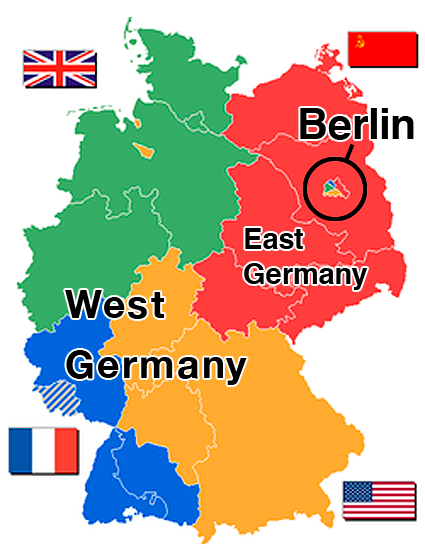
Both countries used the same flag as we know it today, the black, red and gold tricolour.
In 1959, however, the GDR decided to change its flag by adding its coat of arms featuring a hammer and a compass surrounded by a garland of corn symbolizing the workers’ and farmers’ state.
The change of the flag became a touchy issue in the West. It was seen as an insult to the German people and as a clear attempt to permanently divide Germany. Consequently, West Germany banned the flag. It even became chargeable to display it within their territories.
The flag war eventually affected the national teams of East and West Germany. The first time they were supposed to meet each other in an official ice hockey game after the East’s flag makeover was at the 1961 IIHF World Championship in Geneva and Lausanne, Switzerland.
It was an eight-team round-robin tournament in those days and the two German teams were set to face each other on the last day. Both teams were already out of the medal ranks with East Germany having a 1W-0T-5L record while West Germany stood at 0W-2T-4L.
More than 2,000 fans gathered in the Les Vernets rink to witness the fierce rivalry between the two Germanys, between West and East, capitalists and communists.
Former East German national team player Achim Ziesche recalls the event that unfolded while his team was preparing for the game.
“We were getting ready in the locker room, but we noticed that something was not okay,” he told Deutschlandfunk. “People were running around and they looked sort of helpless. We players didn’t understand what happened, but later we realized that we hadn’t seen anybody from the West German side.”
Some minutes later, the public announcer declared that West Germany refused to play and the game would count as a forfeit and a 5-0 victory for East Germany.
“We were surprised. They were the favourites and we assumed they wouldn’t do that,” Ziesche said. “Not as a team, not as a country and not towards the IIHF and the sporting world.”
The organizers put together a “Swiss selection” so that at least an exhibition game could be staged with East Germany.
The reason for West Germany’s refusal was an order from the government. The President of West Germany’s ice hockey association, Willi Daume, was demanding a guarantee that the East German flag wouldn’t be raised after that game. Otherwise his team would not be allowed to play.
Already in those days the post-game protocol saw the flag of the winning team to be raised, accompanied by the national anthem of the winners. Although the West German team was usually considered as the stronger of the two, Daume didn’t want to take any chances.
A loss to the GDR would be embarrassing, but then he would also lose face in front of his entire nation by hearing the East German anthem while also the outlawed flag were to be raised. So the hockey president drove to Geneva to negotiate with IIHF President, Bunny Ahearne, to change the ceremony protocol regardless of who wins: no anthem, no flags.
Ahearne said no. The ceremony was not be adjusted according to the wishes of some nations.
Daume told the team in the dressing room that they wouldn’t be allowed to play. His players left through the back entrance.
“Our officials were used as a political pawn,” West German national team player Ernst Trautwein recalls. “Thanks God it was the only time I can remember that politicians from our side intervened like this.”
The mix of sports and politics continued each time the teams would meet. East Germany was ahead in 1961 and most time of the ‘60s in ice hockey. This situation changed in the ‘70s when hockey became more professional in West Germany while the East German authorities decided to cut their top league to only two professional teams, Dynamo Berlin and Dynamo Weisswasser. These teams formed the world’s smallest hockey league from 1970 to 1990, and the situation didn’t help the national team.
Only once in the ‘60s did the West Germans display superiority over their brethren. At the 1963 IIHF World Championship in Stockholm, Sweden, the first time both teams were in the A-Pool after the Geneva scandal, the teams finally battled on and not off the ice.
East Germany finished one place ahead of the West, but the West won the head-to-head German clash, 4-3. During the post-game ceremony, the East German players ostentatiously turned their backs towards the West German flag.
It took some decades of political division and rivalry until East Germany had its revolution and Germany became unified again in 1991.
While the East Germans competed in the World Championships on a regular basis from 1956 to 1990, they discontinued their Olympic hockey program after 1968, choosing to take the approach of funding single athletes who could win multiple medals, such as a track and field athlete, swimmers and speed skaters, rather than funding an entire team who could only hope to win a single medal, such as water polo or in ice hockey, which frankly was a long shot when up against the likes of the Soviet Union, Czechoslovakia, Sweden and Canada.
Also unusual is the East Germans choice of a primarily blue jersey, as the colors of the East German flag were black, gold and red. Additionally, many of the communist ruled nations favored primarily red sweaters, the Soviet Union and Czechoslovakia in particular.
Today's second featured jersey is a 1989 West German National Team Udo Keissling jersey from the World Championships held in Stockholm, Sweden. West Germany would finish the Round Robin portion with a 0-5-2 record, but avoid relegation by finishing with a 1-2-0 record and save themselves from the drop with a 2-0 defeat of Poland.

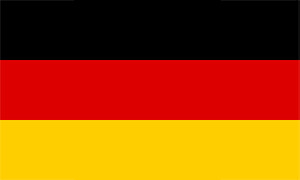
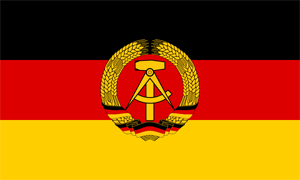
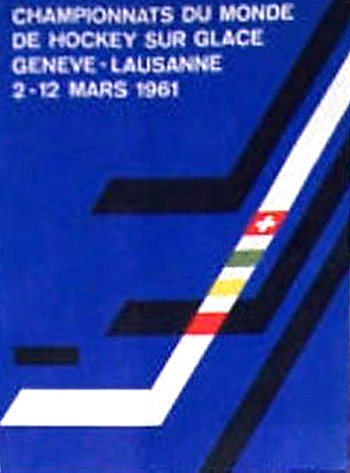
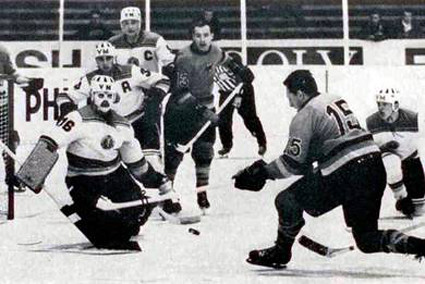
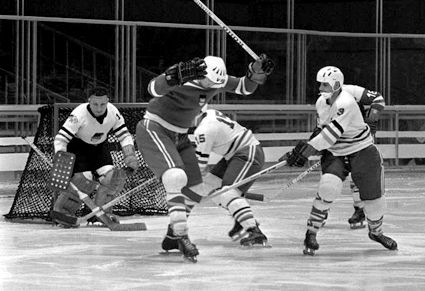
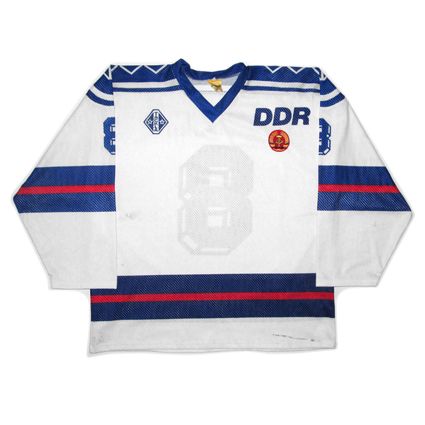
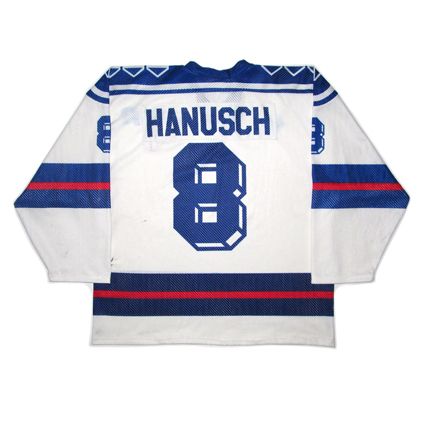
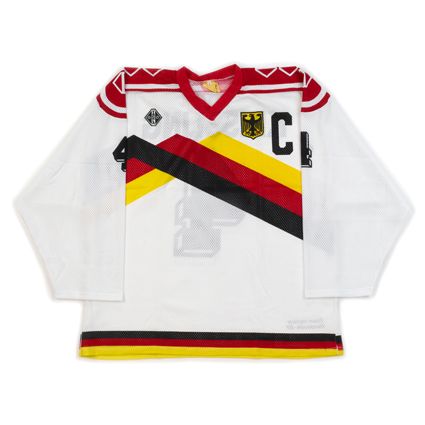
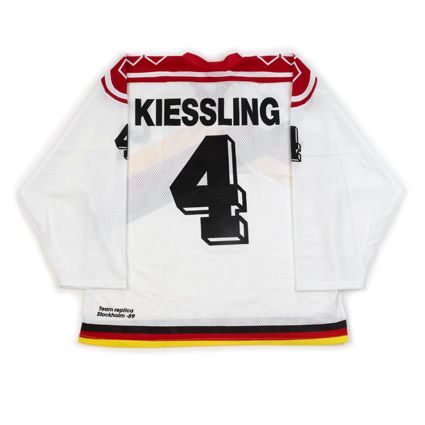










No comments:
Post a Comment
We welcome and encourage genuine comments and corrections from our readers. Please no spam. It will not be approved and never seen.